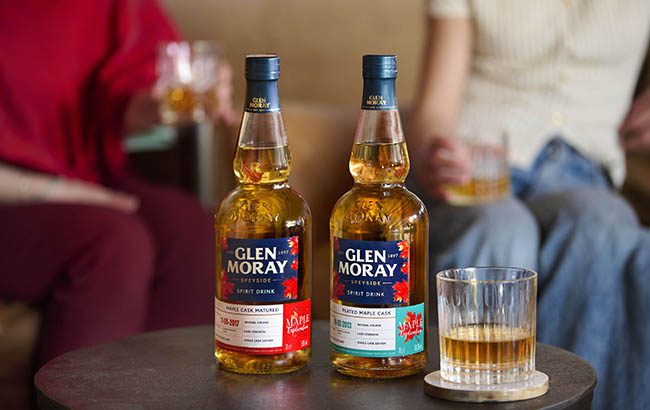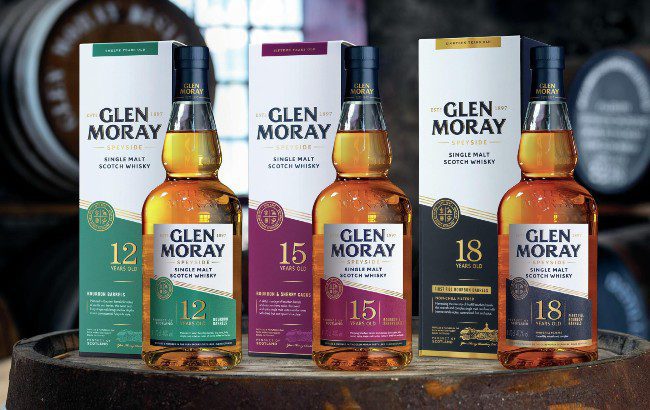Glen Moray plans for more whisky experimentation
By Rupert HohwielerIain Allan, global brand ambassador for Glen Moray, speaks about the Speyside distillery’s latest play in innovation: maple syrup casks.

Glen Moray released two ‘spirit drinks’ at the start of summer finished in maple syrup casks, one peated and the other non-peated, both of which could not be labelled as whisky due to SWA (Scotch Whisky Association) regulations.
Speaking to The Spirits Business about release, the Scotch brand’s global brand ambassador, Speysider Iain Allan, says it was polarising – but reactions of this nature can only be good for the category.
“Watching it unfold on social media has been a lot of fun – it has divided people. We’ve had posts of people who’ve sampled it in a tasting and gone ‘this best thing we’ve ever tried’ and got on the phone immediately and ordered four bottles, and then we have others who are like ‘yep, not for me, too sweet, too much’,” he says.
“That’s great to see. It’s creating discussion and conversation in a category.
“It’s very hard to find these interesting, exciting things, so to come across something which nobody tried before – within Scotch – we thought, we have to try this out and see how it worked.”
The release was limited to 233 bottles as a distillery-exclusive and was made available for the Spirit of Speyside festival, a time when plenty of whisky enthusiasts are knocking around and who are also perhaps the ones more open to trying and experiencing something completely new and different.
Being able call it Scotch or not wasn’t a major issue, as Allan explains: “Everything else we’ve done is ticking that box of Scotch. It’s just the transfer, as they’d aged to the point where they were Scotch; the peated expression was moved as a nine-year-old Scotch into the maple cask for a two-year finish. The non-peated one was five-year-old liquid and put into the maple cask for the two-year finish.
“We weren’t filling thousands of these casks because it’s too big a risk to take and you could end up with something you really have no avenue for.
“We have four maple casks and two others were filled with new make spirits, so they are tucked away in a warehouse and they probably won’t see the light of day for another few years. But with these ones, we felt the quality was there and we really loved them internally.
“We thought, wouldn’t it be great to get these out and let other people try them as well?
The maple cask release is a continuance of the ‘cask explorer’ identity the distillery has become know for, where it experiments with how different woods impact flavour.
Allan adds that the decision was made consciously to take the spirit beyond whisky.
“It had matured into Scotch, but with the transfer into the [maple] cask, we knew that ultimately it would negate it from being called Scotch – but we wanted to see how it would work. These things are all very well and good, but they have to old up taste at the end of it,” Allan says.
The launch also was delayed, Allan says, and was meant to be brought out last year but was held back for a couple reasons. Allan himself did a tour in Canada with a few tasting and had some samples of the maple finish in his suitcase.
“I thought to try it out with the locals because if they were going to like it, then we knew we were on to a winner. And right off it went down really well. It’s the first time I’ve had a round of applause for whisky. They loved it.”
Future releases
Regarding plans for more innovation, Allan says he doesn’t think the brand has anything quite as adventurous as maple, but head of whisky creation Stephen Woodcock is always on the lookout for anything slightly unique and different.
“First and foremost, Stephen has to ensure that we’ve got stock laid down for the forecasts of our core range and then what’s left over at the end, we can look at playing around with,” Allan says.
Of what new things the brand does have up its sleeve, Allan reveals a Tequila cask finish will launch soon.
“I’m fully aware that a few other brands have already done this since the freedom and availability to access [these casks] was permitted by the SWA back in 2019, but it’s not something overly readily available from different brands, so we’ll be bringing those out very soon,” he notes.
“That comes under our Warehouse 1 umbrella, which is where we bring out some of our most fun and funky things.
“Last year’s releases were the Rioja casks, so for that, we’ve got a slate for the next four-five years where Stephen’s laid out and planned what we’re going to bring out. That, for the time being, is on a spreadsheet. But sometimes that spreadsheet gets a little bit of adjustment because maybe one set of releases is maturing slightly quicker than others, so they’ll be tweaked and moved around a little bit nearer the time.”
In terms of other interesting finishes under consideration, Allan says the team have their “thinking caps on”, but it’s going to be tricky to beat maple.
He adds: “Any new cask, anything you put down that you’ve never felt before, you are rolling the dice because you don’t know how it’s going to work with your spirit. Even if it’s something which is totally legal and permitted within the boundaries of Scotch, if you’ve never done it before, until you do it, you don’t know what the results are going to be.
“Then again even with that, you don’t know if it’s the right time to take it out – that’s the challenge.”
He suggests the next opportunity could be around different woods.
“Oak is the permitted style for Scotch. So do we try chestnut? Do we try different oak, different wood varieties, to see what that does? Never mind what was in the wood before because that can open up a few new doors of opportunity,” he ponders.

Core focus
Among any talk of experimentation, though, Allan is clear that the focus will always be on the core range.
“That’s our bread and butter, as for any brand. The core range is very traditional. We call it our Heritage range because it’s part of our heritage to 12-year-olds in particular, as it’s the expression we’ve been selling as a company for the longest – Bourbon cask-matured with very traditional Speyside characteristic and that sweet-spice balance,” Allan says.
“These kinds of side projects, limited editions and the special releases, well, we’ve always been an experimental distillery when it comes to casks. We were releasing white wine casks back in the 1990s when wine casks really weren’t an adopted thing by the industry. We then kind of continued that through the 90s and 2000s where we had warehouses full of small pockets of interesting stuff and this has given us an avenue to bring those out.
“Whereas, previously, we probably would have just sold them to independent bottlers or wherever else we could utilise them.”
Allan notes that it’s about balance, or balancing the exciting things with keeping the spine of the brand in place.
“The maple finishes could be considered controversial if you’re a very traditionalist Scotch whisky drinker, but even if it’s not going to be your cup of tea, it isn’t replacing the traditionalist dram, which is like our 12 and our 18 year old. They’ll always be there and they’re always our focus,” he assures.
“This is just about – and I don’t want to underplay it by using the word ‘fun’ – but little fun things that will burn both brightly and very quickly, and then we move on to the next thing. Some will be absolutely for you, and some of them won’t be, but it’s not going to change the core of what we’re doing, which is looking after our core range.
Reflecting on bringing new drinkers into category, he says if the brand can use these products to bring people into Scotch “then fantastic, that’s a win”, and the same goes for piquing interest Glen Moray.
“To me personally, and not from a company point of view, it’s just about seeing where the spirit can go. We’ve got such a versatile spirit, so let’s see what journey it can be taken on if we put it in cask X or cask Y,” he says with enthusiasm.
“We don’t tend to play around too much from the end of production. We’ve got a very consistent and constant production, so we’re not changing barley varieties. We’re not playing around with yeast types. We’re not messing around with our distillation too much. We do switch between peated and non peated, but that’s the extent of our frontend experimentation.
“This is an avenue where we can just see what else we can do with that wonderful spirit that we’re making anyway.”
Related news
World Spirits Report 2025: World whisky
